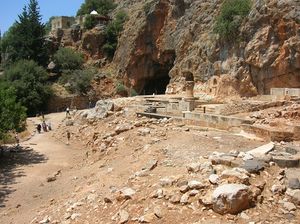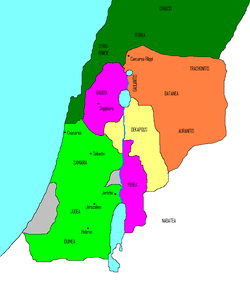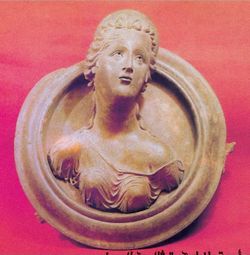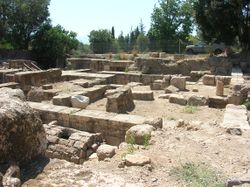قيصرية فلپي
 قيصرية فلپي: أطلال معبد پان مع مغارة پان. المسجد ذو القبة البيضاء هو للنبي الخضر يظهر في المؤخرة. | |
| الاسم البديل | Neronias |
|---|---|
| المكان | مرتفعات الجولان |
| الإحداثيات | 33°14′46″N 35°41′36″E / 33.246111°N 35.693333°E |
| النوع | مستوطنة |
| التاريخ | |
| الثقافات | الهلينية والرومانية |
- يجب ألا يُخلط بينها وبين فيليپي في مقدونيا (باليونان الحالية)، أو مع قيصرية البحرية على البحر المتوسط، أو بلدة قيسارية في إسرائيل، أو مع قيصرية مازاكا في قپادوقيا..(هذا الموقع هو نفسه بانياس الحولة)
- هذا المقال يتعامل مع تاريخ الموقع المعروف اليوم بإسم "بانياس الحولة" بين الفترتين الهلينية والإسلامية المبكرة. للفترات الأخرى، انظر بانياس الحولة
قيصرية فلپي (Caesarea Philippi ؛ اليونانية القديمة: Καισαρεία Φιλίππεια أو قَيصرية پانياس (Καισαρεία Πανειάς)؛ وسُميت "نيرونيا" Neronias لفترة قصيرة - كانت مدينة رومانية قديمة تقع عند السفح الجنوبي الغربي لـجبل الشيخ. وكانت قريبة من نبع ومغارة ومعابد مكرّسة للإله اليوناني پان، وسُميت "پانياس" منذ العصر الهليني، وهو الاسم الذي تحور إلى بانياس، كما نعرفها اليوم (وهي غير بانياس على الساحل السوري على البحر المتوسط). المنطقة المحيطة بها تسمى "پانيون".
The city is mentioned in the Gospels of Matthew[1] and Mark.[2] The city is now nearly uninhabited: it is an archaeological site in the Golan Heights called Banias.
Banias does not appear in the Old Testament. Philostorgius, Theodoret, Benjamin of Tudela, and Samuel ben Samson all incorrectly identified it with Laish (Tel Dan)[3] while Eusebius of Caesarea accurately places Dan/Laish in the vicinity of Paneas at the fourth mile on the route to Tyre.[4]
التاريخ
پانياس الهلينية
Alexander the Great's conquests started a process of Hellenisation in Egypt and Syria that continued for 1,000 years. Paneas was first settled in the Hellenistic period. The Ptolemaic kings, in the 3rd century BC, built a cult centre.
Panias is a spring, today known as Banias, named for Pan, the Greek god of desolate places. It lies close to the "way of the sea" mentioned by Isaiah,[5] along which many armies of Antiquity marched. In the distant past a giant spring gushed from a cave in the limestone bedrock, tumbling down the valley to flow into the Huela marshes. Currently it is the source of the stream Nahal Senir. The Jordan River previously rose from the malaria-infested Huela marshes, but it now rises from this spring and two others at the base of Mount Hermon. The flow of the spring has decreased greatly in modern times.[6] The water no longer gushes from the cave, but only seeps from the bedrock below it.
Paneas was certainly an ancient place of great sanctity and, when Hellenised religious influences were overlaid on the region, the cult of its local numen gave place to the worship of Pan, to whom the cave was dedicated and from which the copious spring rose, feeding the Huela marshes and ultimately supplying the river Jordan.[7] The pre-Hellenic deities that have been associated with the site are Ba'al-gad or Ba'al-hermon.[8]
The Battle of Panium is mentioned in extant sections of Greek historian Polybius' history of "The Rise of the Roman Empire". The battle of Panium occurred in 198 BC between the Macedonian armies of Ptolemaic Egypt and the Seleucid Greeks of Coele-Syria, led by Antiochus III.[9][10][11] Antiochus's victory cemented Selucid control over Phoenicia, Galilee, Samaria, and Judea until the Maccabean revolt. The Hellenised Sellucids built a pagan temple dedicated to Pan (a goat-footed god of victory in battle [creator of panic in the enemy], desolate places, music and goat herds) at Paneas.[12]
العصر الروماني

During the Roman period the city was administered as part of Phoenicia Prima and Syria Palaestina, and finally as capital of Gaulanitis (Golan) was included together with Peraea in Palaestina Secunda, after 218 AD. The ancient kingdom Bashan was incorporated into the province of Batanea.[13]
هيرود وفيليپ (20 ق.م.- 34م)
On the death of Zenodorus in 20 BC, the Panion, which included Paneas, was annexed to the Kingdom of Herod the Great.[14] He erected here a temple of "white marble" in honour of his patron. In the year 3 BC, Philip II (also known as Philip the Tetrarch) founded a city at Paneas. It became the administrative capital of Philip's large tetrarchy of Batanaea which encompassed the Golan and the Hauran. Flavius Josephus refers to the city as Caesarea Paneas in Antiquities of the Jews; the New Testament as Caesarea Philippi (to distinguish it from Caesarea Maritima on the Mediterranean coast).[15][16] In 14 AD, Philip II named it Caesarea in honour of Roman Emperor Augustus, and "made improvements" to the city. His image was placed on a coin issued in 29/30 AD (to commemorate the founding of the city), this was considered as idolatrous by Jews but was following in the Idumean tradition of Zenodorus.[17]
مقاطعة سوريا (34-61م)
On the death of Philip II in AD 34, the tetrachy was incorporated into the province of Syria with the city given the autonomy to administer its own revenues.[18]
"نيرونيا" (61-68م)
In 61 AD, King Agrippa II renamed the administrative capital as Neronias in honour of Roman Emperor Nero: "Neronias Irenopolis" was the full name.[19] But this name held only till 68 AD when Nero committed suicide.[20] Agrippa also carried out urban improvements[21] It is possible that Neronias received "colonial status" by Nero, who created some colonies[22]
During the First Jewish–Roman War, Vespasian rested his troops at Caesarea Philippi in July 67 AD, holding games over a period of 20 days before advancing on Tiberias to crush the Jewish resistance in Galilee.[23]
ارتباطها بالإنجيل
In the Synoptic Gospels, Jesus is said to have approached the area near the city, but without entering the city itself. Jesus, while in this area, asked his closest disciples who they thought he was. Accounts of their answers, including the Confession of Peter, are found in the Synoptic Gospels of Matthew, Mark, and Luke.
Here Saint Peter made his confession of Jesus as the Messiah and the "Son of the living God", and Christ in turn gave a charge to Peter.
According to the Christian ecclesiastical tradition, a woman from Paneas, who had been bleeding for 12 years, was miraculously cured by Jesus.[24]
العصر البيزنطي

يوليان المرتد
بوصوله لمنصب امبراطور الامبراطورية الرومانية في 361م، بدأ يوليان المرتد إصلاحاً دينياً في الدولة الرومانية، كجزء من برنامج استهدف استرجاع العظمة والقوة المفقودتين في الدولة الرومانية.[25] فدعم استرجاع الوثنية الهلينية كديانة للدولة.[26] وفي پانياسى تم انجاز ذلك باستبدال الرموز المسيحية. ويصف سوزومن الأحداث المحيطة باستبدال تمثال للمسيح (والتي شاهدها وكتب عنها أيضاً إيوسبيوس):-
- "ما أن سمعت أن قيصرية فلپي، المعروفة للبعض بإسم "پانياسى پانيادس"، المدينة في فينيقيا، فيها تمثال للمسيح يحتفي به الناس، والذي أقامته إمرأة شفاها الله من نزيف دموي. Julian commanded it to be taken down, and a statue of himself erected in its place; but a violent fire from the heaven fell upon it, and broke off the parts contiguous to the breast; the head and neck were thrown prostrate, and it was transfixed to the ground with the face downwards at the point where the fracture of the bust was; and it has stood in that fashion from that day until now, full of the rust of the lightning." [27]
مطلع العصر الإسلامي
In 635 AD, Paneas gained favourable terms of surrender from the Muslim army of خالد بن الوليد, after the defeat of Heraclius' army. In 636 AD, a newly formed Byzantine army advanced on Palestine, using Paneas as a staging post, on the way to confront the Muslim army at Yarmuk.[28]
The depopulation of Paneas after the Muslim conquest was rapid, as the traditional markets of Paneas disappeared (only 14 of the 173 Byzantine sites in the area show signs of habitation from this period). The Hellenised city fell into decline. The council of al-Jabiyah established the administration of the new territory of the Umar Caliphate, and Paneas remained the principal city of the district of al-Djawlan (the Golan) within Jund Dimashq, jund meaning "military province" and Dimashq being the Arabic name of Damascus, due to its strategic military importance on the border with Filistin (Palestine).[29]
Around 780 AD, the nun Hugeburc visited Caesarea and reported that the town had a church and a "great many Christians".[30]
أسقفية (منذ العهد البيزنطي حتى اليوم)
Caesarea Philippi became the seat of a bishop at an early date: local tradition has it that the first bishop was the Erastus mentioned in Saint Paul's Letter to the Romans (Romans 16:23). What is historically verifiable is that the see's bishop Philocalus was at the First Council of Nicaea (325 AD), that Martyrius was burned to death under Julian the Apostate, that Baratus was at the First Council of Constantinople in 381, and Olympius at the Council of Chalcedon in 451 AD. In addition there is mention of a Bishop Anastasius of the same see, who became Patriarch of Jerusalem in the 7th century.
In the time of the Crusades, Caesarea Philippi became a Latin Church diocese and the names of two of its bishops, Adam and John, are known.[31][32][33][34] No longer a residential bishopric, Caesarea Philippi is today listed by the الكنيسة الكاثوليكية as a titular see.[35] It is also one of the sees to which the Greek Orthodox Church of Antioch has appointed a titular bishop.
الآثار
Today Caesarea Philippi is a site of archeological importance, and lies within the Hermon Stream Nature Reserve.[36] The ruins are extensive and have been thoroughly excavated. Within the city area the remains of Agrippa's palace, the Cardo, a bath-house and a Byzantine-period synagogue can be seen.[37]
انظر أيضاً
للاستزادة
- al-Athīr, ʻIzz al-Dīn Ibn (translated 2006). The Chronicle of Ibn Al-Athīr for the Crusading Period from Al-Kāmil Fīʼl-taʼrīkh: The Years AH 491-541/1097-1146, the Coming of the Franks And the Muslim Response Translated by Donald Sidney Richards, Ashgate Publishing, ISBN 0-7546-4078-7
- Fitzmyer, Joseph A. (1991). A Christological Catechism: New Testament Answers. Paulist Press, ISBN 0-8091-3253-2
- Gregorian, Vartan (2003). Islam: A Mosaic, Not a Monolith. Brookings Institution Press, ISBN 0-8157-3283-X
- Hindley, Geoffrey (2004). The Crusades: Islam and Christianity in the Struggle for World Supremacy. Carroll & Graf Publishers, ISBN 0-7867-1344-5
- Josephus Flavius (1984). The Jewish War. Translated by G. A. Williamson (Revised ed.). Penguin Classics. ISBN 0-14-044420-3.
{{cite book}}: Unknown parameter|editors=ignored (|editor=suggested) (help) - Murphy-O'Connor, Jerome (2008). The Holy Land: An Oxford Archaeological Guide from Earliest Times to 1700. Oxford University Press US, ISBN 0-19-923666-6
- Polybius (1979). The Rise of the Roman Empire. Translated by Ian Scott-Kilvert; Introduction by Frank William Walbank. Penguin Classics. ISBN 0-14-044362-2.
- Richard, Jean (1999). The Crusades, c. 1071—-c. 1291. Cambridge University Press, ISBN 0-521-62566-1
- Salibi, Kamal Suleiman (1977). Syria Under Islam: Empire on Trial, 634-1097. Caravan Books, ISBN 0-88206-013-9
الهامش
- ^ Matthew 16:13
- ^ Mark 8:27
- ^ Provan, Long & Longman 2003, pp. 181–183; Wilson (2004), p. 150; de Saulcy & de Warren (1854), pp. 417–418
- ^ de Saulcy & de Warren (1854), p. 418
- ^ Isaiah 9:1
- ^ Wilson (2004), p. 2
- ^ Kent (2007), pp. 47–48
- ^ Bromiley (1995), p. 569
- ^ Perseus Digital Library. TUFTS University Polybius Book 16 para 18
- ^ Perseus Digital Library. TUFTS University Polybius Book 16 para 19
- ^ Perseus Digital Library. TUFTS University Polybius Book 16 para 20
- ^ Chambers Dictionary of Etymology: The Origins and Development of Over 25,000 English Words Edited By Robert K. Barnhart, Sol Steinmetz (1999) Chambers Harrap Publishers L, ISBN 0-550-14230-4, p 752
- ^ "The Edinburgh New Philosophical Journal". google.com.
- ^ Wilson (2004), p. 9
- ^ Matthew. 16:13
- ^ Flavius, Antiquities of the Jews Book XVIII chapter II para 1 (p. 402)
- ^ Wilson (2004), pp. 20–22
- ^ Wilson (2004), p. 23
- ^ Neronias Irenopolis
- ^ Madden, Frederic William (1864) History of Jewish Coinage, and of Money in the Old and New Testament B. Quaritch, p 114
- ^ "As for Panium itself, its natural beauty had been improved by the royal liberality of Agrippa, and adorned at his expenses" (Flavius, War of the Jews, Book III, chapter X, para 7 (p. 584)).
- ^ Caesarea Philippi under Nero was called "Neronias" (in Spanish)
- ^ Emil Schürer, Fergus Millar, Géza Vermès (1973) The History of the Jewish People in the Age of Jesus Christ (175 BC-AD 135) Continuum International Publishing Group, ISBN 0-567-02242-0 p 494
- ^ Luke; 8:43. Mark 5:23 Matthew 9:20
- ^ Norwich (1988), pp. 88–92
- ^ Brown (1971), p. 93
- ^ Wilson (2004), p. 99
- ^ Wilson (2004), p. 114
- ^ Wilson (2004), pp. 115–116
- ^ Wilson (2004), pp. 118–119
- ^ Pius Bonifacius Gams, Series episcoporum Ecclesiae Catholicae, Leipzig 1931, p. 434
- ^ Michel Lequien, Oriens christianus in quatuor Patriarchatus digestus, Paris 1740, Vol. II, coll. 831-832
- ^ Konrad Eubel, Hierarchia Catholica Medii Aevi, vol. 1, p. 387; vol. 5, p. 305; vol. 6, p. 326
- ^ Raymond Janin, v. Césarée de Philippe, in Dictionnaire d'Histoire et de Géographie ecclésiastiques, vol. XII, Paris 1953, coll. 209-211
- ^ Annuario Pontificio 2013 (Libreria Editrice Vaticana 2013 ISBN 978-88-209-9070-1), p. 867
- ^ Hermon Stream (Banias) Nature Reserve at INPA website
- ^ article at biblewalks.com
ببليوگرافيا
- Bromiley, Geoffrey W. (1995). International Standard Bible Encyclopedia: A–D. Wm. B. Eerdmans Publishing. ISBN 0-8028-3781-6.
{{cite book}}: Invalid|ref=harv(help) - Brown, Peter (1971). The World of Late Antiquity. New York: W. W. Norton. ISBN 0-393-95803-5.
{{cite book}}: Invalid|ref=harv(help) - de Saulcy, Louis Félicien Joseph Caignart; de Warren, Édouard (1854). Narrative of a Journey Round the Dead Sea, and in the Bible Lands; in 1850 and 1851. Including an Account of the Discovery of the Sites of Sodom and Gomorrah. Parry and M'Millan.
{{cite book}}: Invalid|ref=harv(help) - Flavius, Josephus. The works of Flavius Josephus: in three volumes; with illustrations by Josephus Flavius. Vol. 1. Translated by Whiston, William. London & New York: George Routledge & Sons. pp. 402584.
{{cite book}}: Invalid|ref=harv(help) - Kent, Charles Foster (2007) [1912]. Biblical Geography and History. Read Books. ISBN 1-4067-5473-0.
{{cite book}}: Invalid|ref=harv(help) - Norwich, John Julius (1988). Byzantium; the Early Centuries. Penguin Books. ISBN 0-14-011447-5.
{{cite book}}: Invalid|ref=harv(help) - Provan, Iain William; Long, V. Philips; Longman, Tremper (2003). A Biblical History of Israel. London: Westminster John Knox Press. pp. 181–183. ISBN 0-664-22090-8.
{{cite book}}: Invalid|ref=harv(help) - Wilson, John Francis (2004). Caesarea Philippi: Banias, the Lost City of Pan. I. B. Tauris. ISBN 1-85043-440-9.
{{cite book}}: Invalid|ref=harv(help)
وصلات خارجية
- Pages using gadget WikiMiniAtlas
- CS1 errors: unsupported parameter
- مواقع هلينية في سوريا
- Ancient Jewish history during the Roman Empire
- مواقع أثرية في محافظة القنيطرة
- Classical sites on the Golan Heights
- كل سوريا
- أماكن الحملات الصليبية
- أماكن مأهولة سابقاً في مرتفعات الجولان
- مدن مقدسة
- Medieval sites on the Golan Heights
- مدن الإنجيل
- مواقع عبادة پان
- أماكن مأهولة في الامبراطورية البيزنطية
- المملكة الپطلمية
- مواقع رومانية في سوريا
- الامبراطورية السلوقية
- Titular sees




